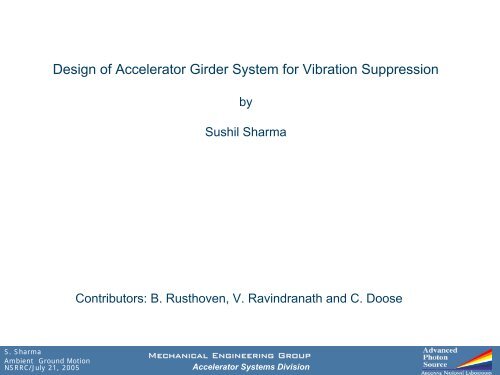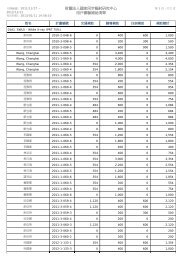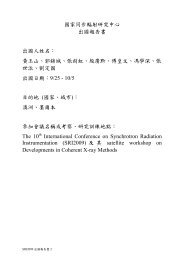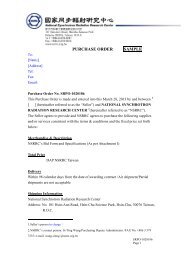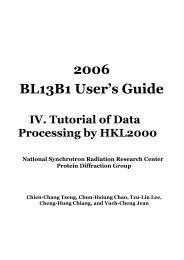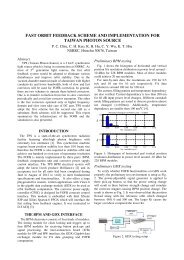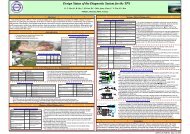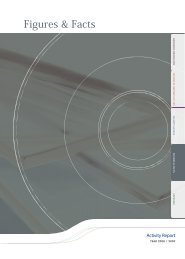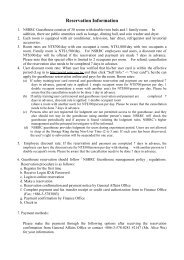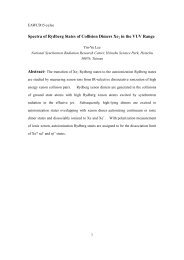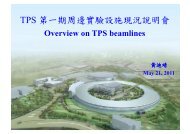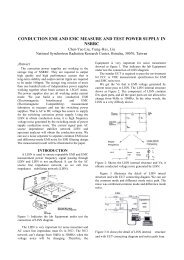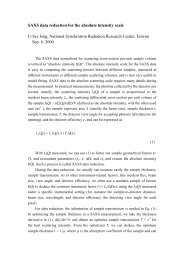Design of Accelerator Girder System for Vibration Suppression
Design of Accelerator Girder System for Vibration Suppression
Design of Accelerator Girder System for Vibration Suppression
You also want an ePaper? Increase the reach of your titles
YUMPU automatically turns print PDFs into web optimized ePapers that Google loves.
S. Sharma<br />
Ambient Ground Motion<br />
NSRRC/July 21, 2005<br />
<strong>Design</strong> <strong>of</strong> <strong>Accelerator</strong> <strong>Girder</strong> <strong>System</strong> <strong>for</strong> <strong>Vibration</strong> <strong>Suppression</strong><br />
by<br />
Sushil Sharma<br />
Contributors: B. Rusthoven, V. Ravindranath and C. Doose<br />
Mechanical Engineering Group<br />
<strong>Accelerator</strong> <strong>System</strong>s Division
Outline<br />
S. Sharma<br />
Ambient Ground Motion<br />
NSRRC/July 21, 2005<br />
An overview <strong>of</strong> some storage ring girder systems<br />
Ambient ground motion<br />
Transmissibility and damping<br />
<strong>Girder</strong> design (materials, geometry and alignment)<br />
Conclusion<br />
Mechanical Engineering Group<br />
<strong>Accelerator</strong> <strong>System</strong>s Division
<strong>Girder</strong> vs. Table<br />
A girder is used <strong>for</strong> several purposes:<br />
1. Provides common plat<strong>for</strong>m (strongback) to<br />
precisely mount several components.<br />
2. Raises components to nominal beam height<br />
(acts as a spacer).<br />
3. Simplifies installation and alignment <strong>of</strong> the<br />
components in the accelerator ring.<br />
4. Expedites realignment (e.g. to compensate <strong>for</strong><br />
floor settlement).<br />
The girder, however, adds another structural element to the system. This<br />
adversely impacts beam stability due to amplification <strong>of</strong> floor motion and thermal<br />
de<strong>for</strong>mations.<br />
S. Sharma<br />
Ambient Ground Motion<br />
NSRRC/July 21, 2005<br />
Mechanical Engineering Group<br />
<strong>Accelerator</strong> <strong>System</strong>s Division<br />
<strong>Girder</strong><br />
Pedestal<br />
APS Storage Ring<br />
Table<br />
APS Linac Bunch Compressor
APS <strong>Girder</strong> <strong>System</strong><br />
First natural frequency is ~ 10 Hz<br />
(Rocking with high center <strong>of</strong> mass)<br />
Higher frequencies (>23 Hz) � quads motion<br />
<strong>Vibration</strong> amplification (rms 4-50 Hz):<br />
no damping: 9<br />
damping with viscoelastic pads: 3<br />
damping with pads and shims: 1.5 (~ 35 nm)<br />
S. Sharma<br />
Ambient Ground Motion<br />
NSRRC/July 21, 2005<br />
Mechanical Engineering Group<br />
<strong>Accelerator</strong> <strong>System</strong>s Division<br />
Wedge Jack<br />
Doose, Sharma [MEDSI 2002]
SPring-8 <strong>Girder</strong> <strong>System</strong><br />
High first natural frequency.<br />
Stiff alignment mechanism.<br />
Six support points.<br />
<strong>Vibration</strong> amplification: 1.9 (48 nm) *<br />
<strong>Vibration</strong> <strong>of</strong> chambers (not magnets)<br />
dominates orbit fluctuations. Nakazato et al.<br />
[MEDSI 2002]<br />
* Sharma et al., [GMV 2000]<br />
S. Sharma<br />
Ambient Ground Motion<br />
NSRRC/July 21, 2005<br />
Mode ω n<br />
1(H) 18.9<br />
2(H) 21.3<br />
3(V) 25.6<br />
4(V) 29.5<br />
5(H) 29.6<br />
Vertical Alignment<br />
Mechanical Engineering Group<br />
<strong>Accelerator</strong> <strong>System</strong>s Division<br />
http://epaper.kek.jp/p01/PAPERS/TPAH117.PDF [2001]
ESRF <strong>Girder</strong> <strong>System</strong><br />
The girder system has several low natural<br />
frequencies.<br />
<strong>Vibration</strong> amplification<br />
without damping: 2.2<br />
with viscoelastic damping link: 1.3 (40 nm)<br />
S. Sharma<br />
Ambient Ground Motion<br />
NSRRC/July 21, 2005<br />
Mechanical Engineering Group<br />
<strong>Accelerator</strong> <strong>System</strong>s Division<br />
Sharma et al. [GMV 2000]<br />
Mode Test<br />
(Hz)<br />
1 8.68<br />
2 11.74<br />
3 13.63<br />
4 22.33<br />
5 26.29<br />
http://www.esrf.fr/machine/reports/sassenage02/<br />
presentations/zhang.pdf
NSRRC <strong>Girder</strong> <strong>System</strong><br />
First natural frequency – horizontal rolling: ~ 15 Hz.<br />
Simple alignment hardware (threaded rods).<br />
Cross-talk <strong>of</strong> flow-induced vibrations in magnets and<br />
vacuum chamber.<br />
<strong>Vibration</strong> amplification:<br />
S. Sharma<br />
Ambient Ground Motion<br />
NSRRC/July 21, 2005<br />
no damping: 1.8<br />
damping with viscoelastic pads: 1.3 (92 nm)<br />
Mechanical Engineering Group<br />
<strong>Accelerator</strong> <strong>System</strong>s Division<br />
Courtesy, D.J Wang, May 2005<br />
Sharma et al. [GMV 2000]
SLS <strong>Girder</strong> <strong>System</strong><br />
Diamond and Boomerang girders are <strong>of</strong><br />
similar design.<br />
Magnets are clamped to precisely machined<br />
girder’s surface.<br />
The magnet support (girder) shows a number<br />
<strong>of</strong> resonances in 15 Hz to 50 Hz frequency<br />
range.<br />
Without cam movers, the calculated<br />
frequencies can be quite high (f1 = 60 Hz <strong>for</strong><br />
Diamond girder, N. Hammond, MEDSI 2002 ).<br />
<strong>Vibration</strong> amplification (rms above 4 Hz): 10<br />
S. Sharma<br />
Ambient Ground Motion<br />
NSRRC/July 21, 2005<br />
Mechanical Engineering Group<br />
<strong>Accelerator</strong> <strong>System</strong>s Division<br />
Cam Mover (SLS)<br />
Machined Top Plate<br />
http://slsbd.psi.ch/pub/varia/dynal_iwbs04.pdf<br />
S. Redaelli et al., EPAC 2004 THPK011
LCLS <strong>Girder</strong> <strong>System</strong><br />
Cam movers are used <strong>for</strong> beam-based alignment.<br />
Cams are attached to the upper girder flange to<br />
minimize thermal de<strong>for</strong>mations and to lower center<br />
<strong>of</strong> mass.<br />
Mode-1 (67.9 Hz) Mode-2 (76.9 Hz) Mode-3 (79.8 Hz)<br />
S. Sharma<br />
Ambient Ground Motion<br />
NSRRC/July 21, 2005<br />
The first four modes correspond to girder de<strong>for</strong>mations<br />
(flexure, torsion, flexure, and flexure).<br />
Modes 5 corresponds to undulator torsion.<br />
Mechanical Engineering Group<br />
<strong>Accelerator</strong> <strong>System</strong>s Division<br />
Mode-4 (99.0 Hz)<br />
Mode-5 (128.8 Hz)
Ground Motion Characteristics<br />
Seryi [2003]<br />
http://www.desy.de/~njwalker/uspas/coursemat/pp/unit_8.ppt#10<br />
S. Sharma<br />
Ambient Ground Motion<br />
NSRRC/July 21, 2005<br />
Mechanical Engineering Group<br />
<strong>Accelerator</strong> <strong>System</strong>s Division<br />
Sharma et al. [GMV 2000]<br />
Ground motion amplitude drops sharply at higher frequencies. The first natural<br />
frequency <strong>of</strong> the support system (girder/magnets + alignment mechanism)<br />
should be as high as possible (preferably, f 1 >20 Hz).
Transmissibility<br />
n = ω<br />
ξ =<br />
2<br />
c<br />
k<br />
mk<br />
m<br />
Transmissibility<br />
S. Sharma<br />
Ambient Ground Motion<br />
NSRRC/July 21, 2005<br />
= fraction <strong>of</strong> critical damping<br />
=<br />
Y<br />
X<br />
=<br />
4ξ<br />
2(<br />
ω / ω 2<br />
n)<br />
+ 1<br />
[ 1−(<br />
ω / ω ) 2]<br />
2 4 2(<br />
/ ) 2<br />
n + ξ ω ωn<br />
For vibration isolation:<br />
• <strong>System</strong>s on s<strong>of</strong>t supports (ω/ω n > √2) � no damping.<br />
• <strong>System</strong>s on very stiff supports (ω/ω1
<strong>System</strong>s on S<strong>of</strong>t Supports<br />
Seismic Isolation and Suspension<br />
<strong>System</strong>s <strong>for</strong> Advanced LIGO<br />
http://www.ligo.org/pdf_public/techpapers_robertson.pdf<br />
[2003]<br />
S. Sharma<br />
Ambient Ground Motion<br />
NSRRC/July 21, 2005<br />
� Limited to comparatively low mass.<br />
Mechanical Engineering Group<br />
<strong>Accelerator</strong> <strong>System</strong>s Division<br />
http://www.minusk.com/
Damping<br />
ξ = fraction <strong>of</strong><br />
η = loss<br />
Q = quality<br />
factor<br />
factor<br />
S. Sharma<br />
Ambient Ground Motion<br />
NSRRC/July 21, 2005<br />
critical<br />
damping<br />
1 ω 2 −ω<br />
1<br />
2ξ<br />
= = = η<br />
Q ω<br />
<strong>System</strong> Viscous Damping, ξ<br />
Metals in elastic range < 0.01<br />
Steel 0.001 – 0.002<br />
Continuous Metal Structures 0.02 – 0.04<br />
Metal Structures with Joints 0.03 – 0.04<br />
Rein<strong>for</strong>ced Concrete Structures 0.04 – 0.07 m&y<br />
& + k(<br />
1+<br />
iη)(<br />
y − x)<br />
= 0<br />
H. Bachmann et al., <strong>Vibration</strong> Problems in Structures, Birkhauser Verlag,<br />
Berlin, 1995.<br />
V. Adams and A Asknazi, Building Better Products with Finite Element<br />
Analysis, OnWord Press, Sata Fe, N.M., 1999.<br />
Mechanical Engineering Group<br />
<strong>Accelerator</strong> <strong>System</strong>s Division<br />
n<br />
Amplitude<br />
ymax<br />
y<br />
max<br />
2<br />
ω 1<br />
ω n<br />
ω 2<br />
Frequency<br />
m&y<br />
& + c(<br />
y&<br />
− x&<br />
) + k(<br />
y − x)<br />
= 0<br />
y max
<strong>Girder</strong> <strong>Design</strong> - Material Properties<br />
Misc. Sources<br />
Flexural <strong>Vibration</strong>:<br />
π ⎡ EI ⎤<br />
f1<br />
≈ ⎢ 3 ⎥<br />
2 ⎣ L ( M + M b)<br />
⎦<br />
S. Sharma<br />
Ambient Ground Motion<br />
NSRRC/July 21, 2005<br />
1/<br />
2<br />
* Bowden [SLAC-TN-05-028, 2002]<br />
Mechanical Engineering Group<br />
<strong>Accelerator</strong> <strong>System</strong>s Division<br />
Comparison (<strong>for</strong> same I and L)<br />
Al Steel Anocast Gr. Epoxy<br />
Frequency (M>>Mb) � E 1/2 8.3 14 6 8<br />
Thermal Bending � α/k * 0.13 0.23 0.70 0.2<br />
Thermal Expansion � α 23.4 12 16.9 2.7
Deflection/Force (in/lbf)<br />
<strong>Girder</strong> <strong>Design</strong> - Anocast Polymer Composite<br />
Seconds<br />
Anocast damps vibrations more<br />
rapidly than aluminum, cast iron, or<br />
granite, by a factor <strong>of</strong> 45, 10 and 4,<br />
respectively.<br />
S. Sharma<br />
Ambient Ground Motion<br />
NSRRC/July 21, 2005<br />
Seconds<br />
Mechanical Engineering Group<br />
<strong>Accelerator</strong> <strong>System</strong>s Division<br />
Seconds<br />
Seconds<br />
http://www.rockwellautomation.com/anorad/downloads/<br />
pdf/Anocast.pdf<br />
http://www-project.slac.stan<strong>for</strong>d.edu/lc/local/notes/tset/Mover/<br />
mover_notes_oct12_post.pdf
<strong>Girder</strong> <strong>Design</strong> - External Viscoelastic Damping<br />
Materials with high structural (internal) damping<br />
may have lower thermal per<strong>for</strong>mance:<br />
L (0.5m) α (20μm/m.ºC) ΔT(0.1ºC) = 1μm<br />
Viscoelastic polymers have high loss factor.<br />
Viscoelastic films absorb vibrational energy<br />
by high cyclic shear de<strong>for</strong>mations.<br />
Many viscoelastic materials are creep and<br />
radiation resistant.<br />
Viscoelastic damping pads (or damping links)<br />
are simple in design and can reduce rms<br />
vibration amplification to ~ 1.2<br />
S. Sharma<br />
Ambient Ground Motion<br />
NSRRC/July 21, 2005<br />
APS Damping Pad and Shim<br />
Mechanical Engineering Group<br />
<strong>Accelerator</strong> <strong>System</strong>s Division<br />
Temperature<br />
http://casl.ucsd.edu/data_analysis/nomograms/isd112.htm<br />
ESRF Damping Link<br />
3M – ISD112<br />
Frequency
<strong>Girder</strong> <strong>Design</strong> – Geometry and Supports<br />
• A box-type cross section is preferable <strong>for</strong> high stiffness in flexure (both directions)<br />
and torsion.<br />
• Full-length welds, gussets and plate stiffeners can significantly increase the<br />
overall stiffness.<br />
SPring-8 Boomerang Diamond<br />
CLS APS<br />
• Unsupported length <strong>of</strong> the girder should be kept as small as possible<br />
(SPring–8 girders are supported at six points).<br />
Supports at Airy Points 3–Point Support<br />
CLS Boomerang<br />
S. Sharma<br />
Ambient Ground Motion<br />
NSRRC/July 21, 2005<br />
Mechanical Engineering Group<br />
<strong>Accelerator</strong> <strong>System</strong>s Division
<strong>Girder</strong> <strong>Design</strong> - Alignment Mechanisms<br />
Threaded Rod<br />
Six-Strut <strong>System</strong><br />
S. Sharma<br />
Ambient Ground Motion<br />
NSRRC/July 21, 2005<br />
Threaded Rod with<br />
Lateral Adjustments<br />
(APS)<br />
Cartridge Adjuster<br />
(CEBAF) *<br />
Wedge Jack (APS)<br />
Motorized Jack (ESRF)<br />
* Other Concepts [1994] http://www-group.slac.stan<strong>for</strong>d.edu/met/IWAA/TOC_S/Papers/RRula95a.pdf<br />
Mechanical Engineering Group<br />
<strong>Accelerator</strong> <strong>System</strong>s Division<br />
http://wwwgroup.slac.stan<strong>for</strong>d.edu/met/IWAA/TOC_S/<br />
PAPERS/KTsum02.pdf<br />
SPring-8 Alignment<br />
http://accelconf.web.cern.ch/AccelConf/<br />
e00/PAPERS/WEP4A17.pdf<br />
Cam Mover (SLS)
Conclusion<br />
Viscoelastic<br />
Film<br />
S. Sharma<br />
Ambient Ground Motion<br />
NSRRC/July 21, 2005<br />
Low center-<strong>of</strong>-mass to reduce vibrations (and thermal de<strong>for</strong>mations).<br />
- Why a beam-height <strong>of</strong> 1.4 m?<br />
Compromise between high stiffness and ease-<strong>of</strong>-alignment:<br />
- Simple alignment mechanism.<br />
- Fasten magnets directly on precisely machined girder’s surface.<br />
Reduce flow-induced vibrations and cross-talk by viscoelastic damping.<br />
<strong>Vibration</strong> mitigation should not be at the expense <strong>of</strong> thermal stability.<br />
Belleville Washers<br />
A Support Concept<br />
Graphite-Epoxy<br />
Locating Slot<br />
Mechanical Engineering Group<br />
<strong>Accelerator</strong> <strong>System</strong>s Division<br />
No <strong>Girder</strong> !<br />
CLS<br />
SPring-8


